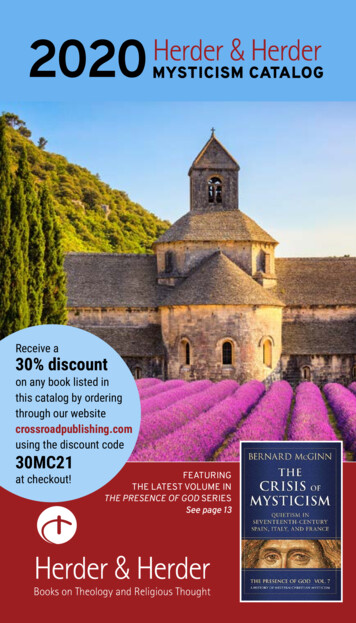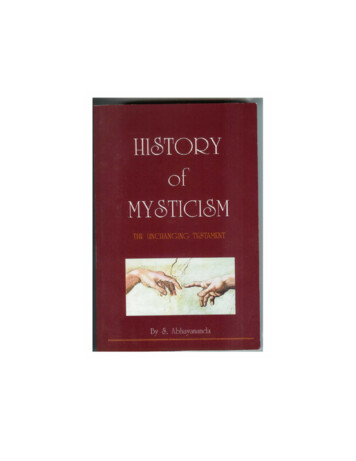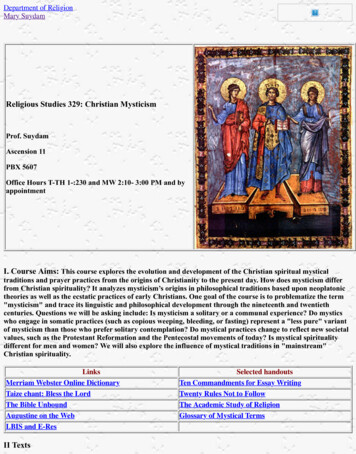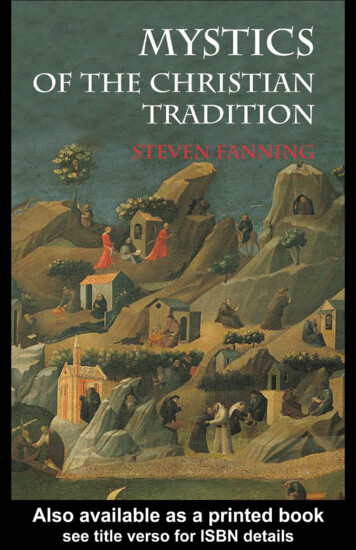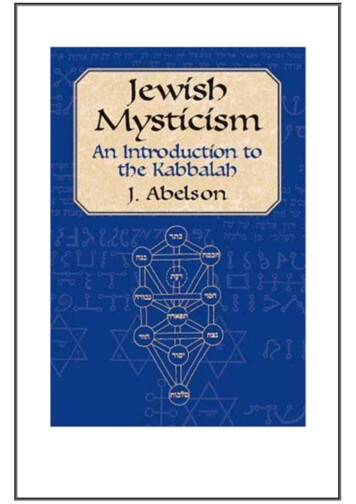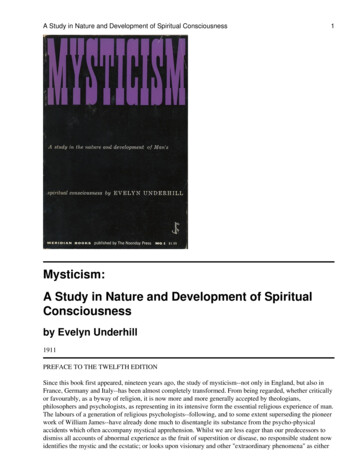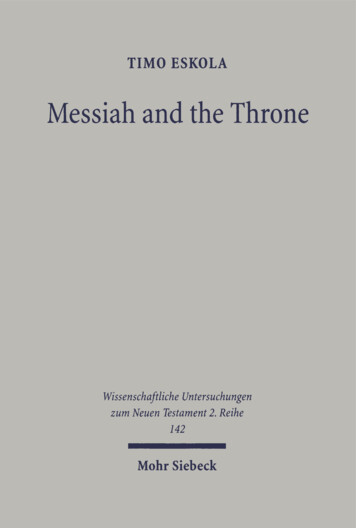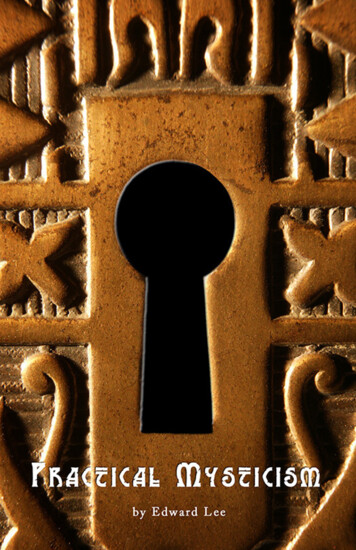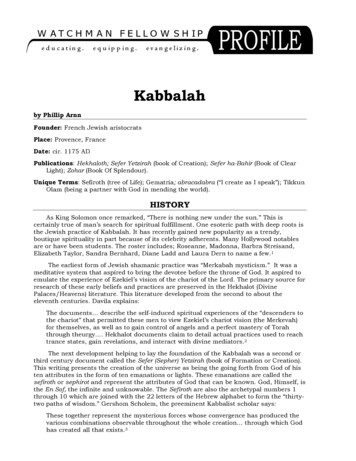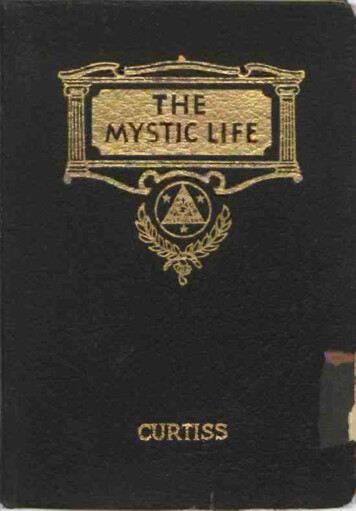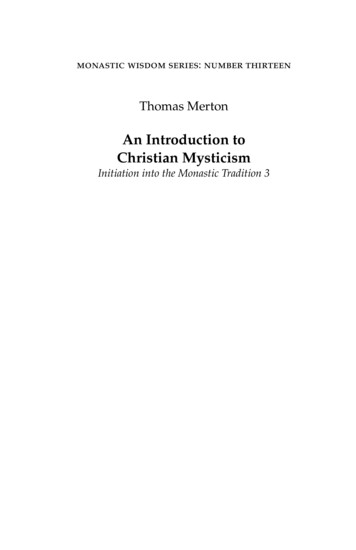
Transcription
monastic wisdom series: number thirteenThomas MertonAn Introduction toChristian MysticismInitiation into the Monastic Tradition 3
monastic wisdom seriesPatrick Hart, ocso, General EditorAdvisory BoardMichael Casey, ocsoTerrence Kardong, osbLawrence S. CunninghamKathleen NorrisBonnie ThurstonMiriam Pollard, sian and the Fathers:Initiation into the Monastic TraditionThomas Merton, ocsoSecret of the Heart: Spiritual BeingJean-Marie Howe, ocsoInside the Psalms: Reflections for NovicesMaureen F. McCabe, ocsoThomas Merton: Prophet of RenewalJohn Eudes Bamberger, ocsoCentered on Christ: A Guide to Monastic ProfessionAugustine Roberts, ocsoPassing from Self to God: A Cistercian RetreatRobert Thomas, ocsoDom Gabriel Sortais:An Amazing Abbot in Turbulent TimesGuy Oury, osbA Monastic Vision for the 21st Century:Where Do We Go from Here?Patrick Hart, ocso, editorPre-Benedictine Monasticism:Initiation into the Monastic Tradition 2Thomas Merton, ocsoCharles Dumont Monk-Poet: A Spiritual BiographyElizabeth Connor, ocsoThe Way of HumilityAndré Louf, ocsoFour Ways of Holiness for the Universal Church:Drawn from the Monastic TraditionFrancis Kline, ocsoAn Introduction to Christian Mysticism:Initiation into the Monastic Tradition 3Thomas Merton, ocso
monastic wisdom series: number thirteenAn Introduction toChristian MysticismInitiation into the Monastic Tradition 3byThomas MertonEdited with an Introduction byPatrick F. O’ConnellPreface byLawrence S. CunninghamCistercian PublicationsKalamazoo, Michigan
The Merton Legacy Trust, 2008All rights reservedCistercian PublicationsEditorial OfficesThe Institute of Cistercian StudiesWestern Michigan UniversityKalamazoo, Michigan 49008-5415cistpub@wmich.eduThe work of Cistercian Publications is made possible in part by support fromWestern Michigan University to The Institute of Cistercian Studies.Library of Congress Cataloging-in-Publication DataMerton, Thomas, 1915–1968.An introduction to Christian mysticism : initiation into the monastictradition 3 / by Thomas Merton ; edited with an introduction byPatrick F. O’Connell ; preface by Lawrence S. Cunningham.p. cm. — (Monastic wisdom series ; no. 13)Includes bibliographical references and index.ISBN 978-0-87907-013-71. Mysticism. I. O’Connell, Patrick F. II. Title. III. Series.BV5082.3.M47 2007248.2'2—dc22Printed in the United States of America2007037374
TABLE OF CONTENTSPreface viiIntroductionxiAn Introduction to Christian Mysticism 1Appendix A: Textual Notes349Appendix B: For Further ReadingAcknowledgementsIndex393391381
PREFACEIn the 1949–1951 correspondence between the newly ordained Thomas Merton and his abbot, James Fox, later publishedin The School of Charity, there is a discussion about the educationof young monks that is extraordinarily interesting. Merton feltthat the young men entering the monastery were being educatedfor the priesthood but that there was no coherent program ofmonastic formation. At a time when it was universally assumedthat choir monks would go on for the priesthood, the educationof these young monks was, of necessity, a course of studies laidout by canon law as a prerequisite for ordination, with instructions in monasticism of necessity ancillary to that demand. It isclear that Merton saw something fundamentally out of balancewith this arrangement but was unsure how to right the balance.He recognized, as he noted in a letter to Dom James, that it wasdifficult to see how one could superimpose a monastic curriculum on top of the seminary curriculum. His solution, first asmaster of scholastics and later as novice master, was to developa course of instructions for novices and the newly professed thatwent under the generic name of “monastic orientations.”The net result of Merton’s convictions was a whole series ofcourses designed for novices or, in the case of this volume, a kindof “post-graduate” seminar for newly ordained priests. Anyonewho has visited the Merton archives in Louisville can inspect thevast pile of bound mimeographed volumes that give witness tohow seriously he took this task of monastic education. Howgrateful we are that Patrick O’Connell has undertaken the arduous task of seeing some of these volumes to publication. O’Connellvii
viiiAn Introduction to Christian Mysticismhas set a high standard with his editions of Merton’s novitiatenotes Cassian and the Fathers (2005) and Pre-Benedictine Monasticism (2006), and we are now in his debt with An Introduction toChristian Mysticism.We might begin by noting that in the early 1960s a widesurvey of Christian mysticism was somewhat of a novelty. In thestandard seminary curriculum there was at least a one-semestercruise through Adolphe Tanquerey’s scholastic manual on ascetical theology. To complicate matters, both primary and secondarysources were in short supply in English. Merton compiled thesenotes nearly two decades before the first volume of the PaulistPress “Classics of Western Spirituality” saw the light of day anda generation before Bernard McGinn published the first volumeof his massive history of the subject. As O’Connell notes, Merton,thanks to his linguistic skills, had to draw heavily on Francophone sources and what little was available to him in Gethsemani’s library. Wisely, Merton drew on primary texts when hehad access to them and studiously avoided the swamp of neoscholastic debates that had been common in the earlier twentiethcentury about the nature of, and distinction between, asceticaland mystical theology.For serious students of Merton’s work this present volume isan estimable resource and that for at least two compelling reasons.First, these notes, as it were, serve as a foundational level for grasping what stands behind such finished works as No Man Is an Island,Thoughts in Solitude, New Seeds of Contemplation as well as many ofhis essays on the spiritual life. That Merton wore his learninglightly is, in fact, the case. Behind the limpid prose of his classicalworks on the spiritual life, however, is a vast well of learning inthe sources. This volume is clearly an example of ressourcementand as such tells us much about Merton’s intellectual and spiritualdevelopment. That he was in intellectual dialogue when givingthis course with von Balthasar, Daniélou, and Leclercq, those masters of ressourcement, should come as no surprise.Second, I think O’Connell makes a crucial point about Merton’s appropriation of an old trope in the Christian mystical
Prefaceixtradition. In a distinction as old as Origen’s prologue to his commentary on the Song of Songs, spiritual writers have noted thatbetween the stage of purification (ethike) and the profound encounter with God (theologia) there is the human grasp of the presence of God in the created cosmos which was called theoria ortheoria physike. The later tradition would call that the stage of illumination between purification and union but the point is, andO’Connell correctly notes it, that an appreciation of theoria is acrucial key to help explain what seems to be in Merton simply abyproduct of his enormous curiosity: Zen calligraphy, Shakerfurniture, the abstract art of Ad Reinhardt, and so on. In fact, itwas a new way of “seeing” (theoria, at root, mean “gazing”) andis part of the contemplative process. The value of theoria is, ofcourse, that it means that the penitential life is not an end in itselfbut a preparation for a new way of seeing.Merton never pursued this idea in any systematic fashionbut one can see in it a kind of a theology of culture broadly understood. Not only did Merton see contemplative union open toevery baptized Christian but he strongly asserted that one cancultivate the eye to see in a fresh new way. Not to put too fine apoint on it: if one hopes to grasp the mind of Thomas Mertonand not be satisfied with clichés and stereotypes then one musttake into account these profound academic exercises. They are akey to his understanding of the contemplative life as, for example,he describes it in the opening pages of New Seeds of Contemplation.Finally, a sympathetic reader of this volume needs to advertto the word “introduction” in the title. After all, had Merton donean in-depth study of Augustine or Bonaventure or Eckhart or thegreat Carmelites this would not have been a book but a set ofbooks. One would better think of this work as a set of blaze marksto work one’s way through the complex story of Christian mysticism. One makes that journey with a deeply serious and widelyeducated guide who is able to point out the salient landmarks ofthe mystical tradition. “Guide” I think is the right word. SaintJohn of the Cross never spoke of a spiritual director but frequently
An Introduction to Christian Mysticismspoke of the spiritual guide (guia) and the spiritual teacher (maestro espiritual) and in Merton one finds both.In reading these pages I was struck how Merton attemptedto mend the long historical rift between systematic theology andthe contemplative theology normative in the Church before therise of scholasticism. He was not spinning out some variety ofspiritual gnosis but, rather, recalled to his students, and now,gratefully, to us, the truth of one of Saint Thomas Aquinas’s mostprofound observations, namely, that faith has as its final end notwhat is articulated but the reality behind that articulation (nonad enuntiabile sed ad rem).Lawrence S. CunninghamThe University of Notre Dame
INTRODUCTIONThe series of conferences that comprise An Introduction toChristian Mysticism is unique among the courses taught byThomas Merton during his term as novice master at the Abbeyof Gethsemani (1955–1965) in that it was not intended for orpresented to the novices. On January 14, 1961, Merton had written to Herbert Mason, “In March and April I have to teach eighteen lectures in mystical theology in the new pastoral course forour young priests, and this is keeping me busy.” By the time thelectures actually started the number had expanded to twenty-two(15), to be given twice a week, evidently, during March, Apriland May. The course duly began on March 1 and continued . Thomas Merton, Witness to Freedom: Letters in Times of Crisis, ed. WilliamH. Shannon (New York: Farrar, Straus, Giroux, 1994), 270. . See Merton’s letter of March 9, 1961 to Robert Lax: “What makes memost busy at the moment is twenty two lectures on mystical theology. This issome of the vanity which God hath given men to be exercised therein” (ThomasMerton and Robert Lax, When Prophecy Still Had a Voice: The Letters of ThomasMerton & Robert Lax, ed. Arthur W. Biddle [Lexington: University Press of Kentucky, 2001], 219). Two lists of preliminary outlines of the course each includetwenty-two classes: the earlier, in pencil, indicates the first eight classes as assigned to March, the next six to April, and the last eight to May; for transcriptions of the two outlines, see Appendix A, pages 349–50 (the later outline, inpen), and 351 (the earlier, in pencil). . See Merton’s journal entry for March 3, 1961: “I started the mysticaltheology class Wednesday (Mar. 1)” (Thomas Merton, Turning Toward the World:The Pivotal Years. Journals, vol. 4: 1960–1963, ed. Victor A. Kramer [San Francisco:HarperCollins, 1996], 97).xi
xiiAn Introduction to Christian Mysticismthrough May 19, when Merton noted in his journal, “Finishedthe official mystical theology course today. Some extra classes tobe fitted in where I can.” In fact, however, these extra classescontinued at least throughout the summer. The Foreword to themimeographed text of the course notes is dated “Vigil of the Assumption, 1961” (i.e., August 14) (4), but the classes continuedat least into the following month. On September 9, Merton wroteto Etta Gullick, “I had a mystical theology course which is gettingprolonged by a ‘popular demand’ which I suspect to be ninetypercent nonsense and ten percent pure illusion. And it requiresa lot of preparation.” The day before, he had noted in his journal,“So I teach and teach, not only novices. This mystical theologyclass drags on and on. The young priests now want some sort ofseminar, and I think it is foolish, a waste of time, yet to pleasethem and soothe my guilt feelings—and perhaps to satisfy myvanity—I suppose I will do it. I wish I could call it love.” Thereis no further mention in journal or letters of the mystical theologycourse, nor are there any subsequent references to a seminar for . Omitting two classes during Holy Week (March 26–April 1), this wouldhave been the twenty-second class if the course met twice per week. . Turning Toward the World, 120; Merton writes of “still slugging {slogging?} along with mystical theology” in a letter of May 10 to Sr. Thérèse Lentfoehr (Thomas Merton, The Road to Joy: Letters to New and Old Friends, ed. RobertE. Daggy [New York: Farrar, Straus, Giroux, 1989], 238), but three days later hewrites to Abdul Aziz, “I have been taken up with more numerous classes forthe last three months, but this is now ending. I will send you the notes of theseclasses in mystical theology when they are ready” (Thomas Merton, The HiddenGround of Love: Letters on Religious Experience and Social Concerns, ed. William H.Shannon [New York: Farrar, Straus, Giroux, 1985], 48), and on the same day hewrites to Mark Van Doren, “For three months I have been pounding away at amad course in mystical theology and have enjoyed the sweating, but it is finallyending and I enjoy that more. It is always racking to talk about what shouldnot be said” (Road to Joy, 41). On the last day of the official course, he tells JohnWu, “I have been busy finishing up my course in mystical theology and variousother tasks” (Hidden Ground of Love, 616). . Hidden Ground of Love, 353. . Turning Toward the World, 160.
Introductionxiiithe young priests, but circumstantial evidence suggests that Merton did continue to meet with the group for some considerabletime subsequent to this entry.While he sounded rather tired of the conferences by thispoint, he had earlier expressed satisfaction that they were speaking to an authentic desire among the monks attending the coursefor a deepened awareness of the contemplative dimension oftheir lives. On March 24, he reflected in his journal on a sessionheld in the new cinderblock cottage that would become hishermitage:Wednesday afternoon (rain). The Pastoral Theology groupand others came to St. Mary of Carmel—conference on theSpiritual Senses and general discussion. A very happy atmosphere and I think everything was profitable—a kindof opening up. Have never had so much of a sense of theneed and the hunger of the priests in the monastery formysticism and contemplation—in a very simple way. It istrue that a large part of our difficulties comes from frustration of this deep need and a kind of inarticulate temptationto despair that takes refuge in activities without too muchsense. As he points out in his Foreword, while the “approach has beenmainly historical and positive in an attempt to recover some ofthe rich thought of the patristic and medieval periods” (3), hispurpose was less strictly academic than formational,an effort to broaden the horizons and deepen the perspectives of mystical theology in a monastic setting. . . . Thelectures were intended primarily for monastic priests ina course of “pastoral” theology—that is to say for monkswho sought background and contact with sources thatwould enable them to be of benefit to their brethren inspiritual direction or in that sapientiae doctrina which St.Benedict looks for in superiors (3). . Turning Toward the World, 102.
xivAn Introduction to Christian MysticismThey reflect Merton’s core belief, the foundation as well of hisnumerous published books on contemplation, that “the Christianmystical tradition is something that has been handed down notonly to be talked about but to be lived” (4).Merton’s original outlines for the course present an ambitious overview of the mystical tradition that in the event he wasnot able to carry out fully. The subtitle of the course, “(From theApostolic Fathers to the Council of Trent),” represents a considerable scaling back of the chronological breadth initially proposed:in the earliest outline, the twelfth class, the beginning of the second half of the course, is labeled “Post Trent—Jesuits—St Theresa.” (351)! It is followed by: “St John of the Cross” [13]; “DarkNight” [14]; “Later Carmelites—mod. Debates” [15]; “Semi Quietists etc” [16]; “Modern Writers—Saudreau Poulain” [17]; “NonXtian mysticism?” [18]; “Hallaj—Sufis” [19] (n. 20 is left blank,presumably for a second class on this topic); “Byzantine Mysticism” [21]; “St Gregory Palamas” [22]. The semi-Quietists andmodern writers were already cancelled on this first outline tomake room for two additional classes on “Franciscans—RhenishMystics” and “Complete Separation of Myst Theol” (the latteritself subsequently cancelled) to precede the “Post Trent” class.By the time Merton put together his second outline (349–50) theJesuits and St. Teresa had moved all the way to class 19 (whichwas then switched to 20), followed only by “St John Cross DarkNight” (originally 18-19, then 20-21, and finally just 21); “LaterCarmelites” (subsequently added to the Jesuits and Teresa class);and “Byz. Myst. Conclusion” (originally two classes reduced toone). In the actual text, however, the Byzantines have disappeared along with the non-Christians. In fact in his ForewordMerton writes, “It has not been possible to carry out our originalintention to discuss St. John of the Cross and the Byzantine mystical tradition” (3), though in the final text John of the Cross does . In his January 14 letter to Herbert Mason, Merton had written, “I wantto bring in Hallaj and maybe other Oriental mystics if I have elbowroom” (Witness to Freedom, 270).
Introductionxvreceive extensive discussion, in a context that reflects a considerable reorientation found in what were evidently the “extraclasses” added after the formal conclusion of the course, andmore specifically those which were subsequent to the writing ofthese prefatory remarks in mid-August.10Merton’s plans for what was initially to be the first half ofthe course remain quite consistent in topics, if not in number ofclasses, in the two outlines, and are followed closely in the actualtext of the conferences. After a pair of introductory classes, thetopics include: St. John’s Gospel, Martyrs, Gnostics, Divinization,Christological Controversies, the meaning of the term “mysticism,” Gregory of Nyssa, the spiritual senses, Evagrius, PseudoDionysius, “Western Mysticism,” the Dionysian tradition in theWest, the Franciscans, the Rhenish mystics, Quietism, and theseparation of mysticism and theology. Except for the last two,which are treated only in passing, this list accurately representsthe actual development of the course as found in the writtennotes. The only significant differences between the two versionsof the outline for these sections of the course are the omission ofmention of Pseudo-Macarius in the second version,11 and theaddition of “Theoria Phys[ike],” which becomes an extremelyimportant section of the course as finally written.The only topic that receives major attention in this part ofthe course that is not specifically mentioned in the outlines isBéguine spirituality, which is discussed in some detail under thegeneral heading of “Fourteenth-Century Mysticism” (“The 14th–15th Cents.” in a secondary, marginal list on the second outline).10. Merton notes in his journal that he is “writing up mystical theologynotes” on August 11 (Turning Toward the World, 150).11. Merton included a section on Pseudo-Macarius in the “Prologue to Cas sian” section of his novitiate course on Cassian and his predecessors (ThomasMerton, Cassian and the Fathers: Initiation into the Monastic Tradition, ed. Patrick F.O’Connell, Monastic Wisdom [MW], vol. 1 [Kalamazoo, MI: Cistercian Publications, 2005], 81–88), which may have prompted him to omit discussion of thisauthor here, as was the case with Origen (see below, xxi)—though not of Gregoryof Nyssa or of Evagrius.
xviAn Introduction to Christian MysticismHowever, following the section on St. Teresa, the entire rest ofthe text of the course consists in material not included at all inthe projected outlines of the course, namely a lengthy section on“The Spiritual Direction of Contemplatives” followed by a secondsection on the same topic, subtitled “Direction in the Crises ofthe Mystical Life” (along with two appendices to be consideredlater). These sections, which comprise 44 pages of a total of 170in the mimeographed version of the text proper, evidently owetheir existence to the continuation of the course beyond its intended limit of twenty-two classes, and to another project onwhich Merton was engaged during the period of the “extraclasses” of the summer and early fall of 1961.From indications in Merton’s journal and letters, it is possible to get some sense of the progression of classes: during Marchhe appears to be keeping to his schedule, or perhaps even slightlyahead, as he is discussing the topic of the spiritual senses (class8 on the outlines) at the hermitage during what appears to be hisseventh class.12 But the pace apparently slows subsequently, sincein his May 13 letter to Mark Van Doren, less than a week beforethe formal end of the class, he writes, “I ended up last time Beguines, beguines and beguines. They were wonderful, like thequails around my house. Everybody has forgotten them, but theywere very wise and Eckhart learned all the best things he knewfrom them.”13 In the two remaining “regular” classes he couldhardly have progressed beyond the Rhineland mystics, Eckhartand Tauler, and in fact his frequent mentions of Eckhart in letters12. If the classes were held on the same days each week, as seems likely,they were given on Wednesdays (the day on which the first class was held—March 1) and Fridays (the day of the final class—May 19); the entry for March24 is unclear, since it begins “Wednesday afternoon” but that day was a Friday;presumably he was referring to a class that met two days previous, which wouldhave been the seventh class; if he was mistaken about the day and was actuallyreferring to a class that met on that day, it would have been the eighth class.13. Road to Joy, 41; see also his journal entry from the beginning of thatweek, Sunday, May 7, in which he writes about reading Dom Porion’s book onHadewijch, his major source for the Béguines (Turning Toward the World, 117).
Introductionxviiand journal entries of June and July suggest that he may wellhave continued to discuss these fourteenth-century Germansafter the completion of the course proper.14 Certainly the materialon St. Teresa must have been discussed during these extra summer classes, followed by the additional, new topic of spiritualdirection (unless this was the subject of the “seminar” that thepriests had requested and was thus presented through the fall).The reason for this unexpected change in focus is explainedin letters and journal entries from the summer. In a June 21 letterto Mark Van Doren, he remarks, “I am not writing much at themoment and not intending to write much except for doing choreslike an Encyclopedia article (New Catholic Encyclopedia, whichwill probably be stuffy).”15 He elaborates on the “chore” in ajournal entry for June 29: “New Cath. Encycl. has repeated its request for one article. I am convinced they do it very unwillingly,merely to get my name on their list. I refused before a ludicrousrequest to do 300 words on Dom Edmond Obrecht (!!) and nowthey have asked for 5,000 on spiritual direction and I feel utterlyfoul for having accepted.”16 There is no further mention of thearticle until a September 19 letter to Sr. Thérèse Lentfoehr,17 andthen in his journal five days later he writes, “Have to finish articlefor Catholic Encyclopedia,”18 which he calls a “tiresome task” in aletter of the same day to Dona Luisa Coomaraswamy.19 Finally14. See his letters to Etta Gullick of June 10 and July 1 (Hidden Ground ofLove, 342, 343) and the journal entry of July 4 (Turning Toward the World, 137).15. Road to Joy, 42.16. Turning Toward the World, 135.17. “I have had to write a few articles for a new Catholic Youth Encyclopediawhich, between you and me and the gatepost, sounds rather useless. But maybethey had a method in their madness, and decided to do something that wouldhave more life in it than the New Catholic Encyclopedia. I have a long article to dofor them, too, on ‘Spiritual Direction’” (Road to Joy, 239); his articles on “Contemplation” and “Perfection, Christian,” appeared in The Catholic Encyclopediafor School and Home, 12 vols. (New York: McGraw-Hill, 1965), 3.228-30, 8.328-32.18. Turning Toward the World, 164.19. Hidden Ground of Love, 133.
xviiiAn Introduction to Christian Mysticismon October 10 he writes in his journal, “The other day I finallyfinished the article ‘Direction, Spiritual’ for the New Catholic Encyclopedia. I should have finished it in August (Deadline Nov. 1,but I wanted to get it done in August).”20 Work on this article(which ironically ended up not being accepted for publication inthe New Catholic Encyclopedia21) coincided with the concludingphase of the mystical theology course, and prompted Mertoneither to include a section on spiritual direction at the end of thecourse itself, or perhaps to make it the subject of the “seminar”requested by his students, if such a continuation of these conferences did indeed take place. The latter supposition is perhapsmore likely, as there is no hint of inclusion of this material in theForeword to the notes, written in mid-August, and in fact it isclear that at that time Merton had no idea that he would includea substantial section on John of the Cross in the second, “spiritualcrises” section of the direction material. Given the fact that notquite four weeks separates the writing of the Foreword from thejournal entry mentioning the request for the “seminar,” the ratherabrupt shift in focus, and the quite detailed elaboration of thespiritual direction material, it is at least plausible that this topicbecame the focus of a somewhat distinct set of conferences, whichalso allowed Merton to incorporate material from John of theCross (some of which is related only tangentially to spiritual direction), and which were still related closely enough to the mystical theology material proper to allow them to be included as thetwo final sections of the written notes.As for the material in the appendices, Merton’s only reference to the first comes in a journal entry for December 14, 1961,where he notes that he is reading the Scala Claustralium “for thenovices,”22 an indication that he was intending to use it in regularnovitiate conferences and that it was incorporated into the mysti20. Turning Toward the World, 169.21. The article has now been published in The Merton Seasonal, 32.1 (Spring2007), 3–17.22. Turning Toward the World, 184.
Introductionxixcal theology notes because of the relevance of the material ratherthan because he had or was intending to discuss it with the groupof young priests to whom the course had been given. The secondappendix, on Robert Jay Lifton’s book on brainwashing, is relatedsomewhat tenuously to the spiritual direction material and infact was initially headed “Appendix—to Spiritual Direction” inMerton’s original notes,23 and presumably was added to the noteseven later than the Scala material, perhaps even in early 1962;24it seems unlikely that it was ever discussed with the “seminar,”which presumably had stopped meeting by that time, since it isprobable that some further mention of the group would appearin the journal if it continued to meet on a long-term basis. In anycase, by March 1962, the mimeographed notes on mystical theology had been printed up and not only distributed to those whohad been in the course but sent to various interested parties beyond the confines of the monastery, since in a March letter to Sr.M. Madeleva, president of St. Mary’s College at Notre Dame,Merton mentions having already sent them to her.2523. Merton subsequently crossed out “to Spiritual Direction” and interlined “II” after “Appendix”.24. A discussion of “brainwashing” in a January 25, 1962 letter to VictorHammer is clearly dependent on the Lifton book, and suggests that Merton hadread it recently and it was fresh in his mind: “As for brainwashing, the term isused very loosely about almost anything. Strict technical brainwashing is an artificially induced ‘conversion,’ brought about by completely isolating a personemotionally and spiritually, undermining his whole sense of identity, and then‘rescuing’ him from this state of near-collapse by drawing him over into a newsense of community with his persecutors, now his rescuers, who ‘restore’ hisidentity by admitting [him] into their midst as an approved and docile instrument. Henceforth he does what they want him to do and likes it, indeed findsa certain satisfaction in this, and even regards his old life as shameful and inferior” (Witness to Freedom, 6).25. Witness to Freedom, 43; she was writing to inquire why the Englishmystics, specifically Julian of Norwich, had not been included in the notes (seebelow, pages xxi, xlix–l); Merton had evidently sent the notes in connection withhis role as advisor to St. Mary’s faculty who were in the process of setting up a
xxAn Introduction to Christian Mysticism*******Because Merton’s various courses with the novices wereopen-ended and he had complete control of the schedule, he wasable to develop those sets of conferences according to his owndesigns. The situation with An Introduction to Christian Mysticismwas quite different: the limited number of classes (at least asoriginally projected), as well as the broad chronological sweepof the material, imposed cer
Christian Mysticism. We might begin by noting that in the early 1960s a wide survey of Christian mysticism was somewhat of a novelty. In the standard seminary curriculum there was at least a one-semester cruise through Adolphe Tanquerey’s scholastic manual on asceti-cal theology. To complicate matters, both primary and secondary
